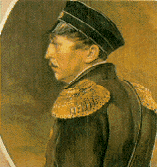| Tell a friend | Print version |
|---|
Admiral P.S. Nakhimov
|
In 1827, he participated in the Battle of Navarino being in command of the battery on the battleship Azov. In this famous battle, along with lieutenant P.S. Nakhimov, the future Russian fleet commanders, namely, midshipman V.A. Kornilov and naval cadet V.I. Istomin demonstrated their courage and valour. The defeat of the Turkish Fleet in the sea Battle of Navarino not only significantly weakened the Turkish naval forces but also largely contributed to the national-liberation movement of the Greeks and Russia’s victory in the Russian-Turkish war of 1828-1829. In the course of this war, Nakhimov was in command of the corvette Navarin, took part in the Dardanelles blockade. On returning to Kronstadt in 1829, Pavel Nakhimov was made Captain of the frigate Pallada. In 1834, he was once again transferred to the Black Sea Fleet to be appointed Commander of the battleship Silistria, which in terms of her service organization, operational training and maneuvering characteristics was considered the best ship of the Black Sea Fleet. Admiral Mikhail P. Lazarev, who was Commander-in-Chief of the Fleet, would place his flag on the Silistria and hold this ship up as an example to other ships of the Fleet.
Afterwards, Pavel S. Nakhimov was in command of the subdivision (from 1845), division (from 1852) and squadron of ships (from 1854) which served in the Caucasus preventing the Turks, instigated by the British, from undermining Russia’s positions and shaking her authority in the Caucasus and the Black Sea Fleet.
Nakhimov managed to reveal his exceptional talent as a naval commander and strategist in the Crimean war of 1853-1856. Being in command of the Black Sea Fleet squadron, Nakhimov spotted and blocked the enemy’s main forces at Sinope, and, on 1 December (18 November) 1853, routed the Turks in the sea Battle of Sinope.
During the Sebastopol defence of 1854-1855, Pavel Nakhimov adequately accessed the strategic importance of Sebastopol and made the right use of all the means available to strengthen the city’s defence. Being the squadron commander and, from February 1855 the commander of the Sebastopol port and military governor of the city, Nakhimov headed the garrison of the heroic defenders of the fortress from the very first days of the defensive operation where he displayed his remarkable abilities as an organizer of the defence of the Black Sea Fleet’s main base both from sea and land.
Under Nakhimov’s skillful command, a scuttling of several wooden sailing vessels at the entrance to the harbour was done which hindered the Turks’ access to it. This extraordinary maneuver was extremely conducive to strengthening the city’s defence from sea. Nakhimov was also responsible for forward-defence fortifications construction and additional coastal batteries erection, which became the backbone of land defence and reserves training. He personally commanded the Russian troops in battles. One of the distinguished features of the Sebastopol defence, led by Nakhimov, was the fact that it was a very active and aggressive one. Sorties made by soldiers and sailors units, counter-battery operations and mine attacks were widely employed. Aimed coastal batteries and ships fire was used to cause the enemy substantial damage. Under the direct command of Nakhimov, Russian soldiers and sailors transformed once poorly-fortified Sebastopol into the formidable and inaccessible fortress which was able to successfully defend itself throughout those long eleven months and repulse several enemy assaults.
Pavel Stepanovich Nakhimov enjoyed immense authority and the love of the Sebastopol defenders. Being put in the most difficult situations, he would always display his coolness under pressure and surprising self-control setting thus a personal example of courage and fearlessness. Admiral’s behavior and the way he comported himself inspired all the citizens of Sebastopol to do their best in the battle against the enemy and perform heroic deeds. He had a real gift of feeling at which sectors of defence the situation was especially critical and he would certainly go there and control the battle himself. On 11 July (28 June) 1855, while inspecting one of the forward-defence positions on the Malakhoff redoubt, Pavel S. Nakhimov was fatally wounded in his head by a sniper.
Following the decree, issued by the Presidium of the USSR Supreme Soviet of 3 March 1944, the Order of Nakhimov with two degrees and the Nakhimov Medal for Navy personnel were established. Naval Colleges named after the great Admiral were opened. One of the cruisers of the Soviet Navy was bearing his name. In Sebastopol, which is often called the city of the Russian glory, a monument in the memory of Pavel Stepanovich Nakhimov was erected in 1959.
The Order of Nakhimov was preserved as one of the highest military decorations in the Soviet Union and, upon its dissolution, in the Russian Federation.




